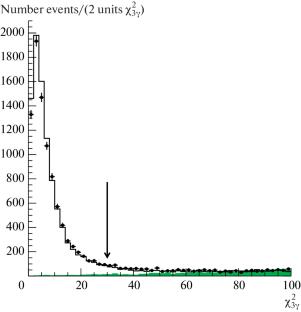Measurement of the \({e^{+}e^{-}\to\pi^{0}\gamma}\) Cross Section near the \({\phi}{(1020)}\) Resonance with the SND Detector
IF 0.4
4区 物理与天体物理
Q4 PHYSICS, NUCLEAR
引用次数: 0
Abstract
The \(e^{+}e^{-}\to\pi^{0}\gamma\) cross section has been measured in the center-of-mass energy range from 1000 to 1060 MeV with the SND detector at the VEPP-2000 electron-positron collider. At the maximum of the \(\varphi\)(1020) resonance the systematic uncertainty of the cross section measurement is 1.3%, and the statistical uncertainty is 2.2%. To date, this is the most accurate measurement of the \(e^{+}e^{-}\rightarrow\pi^{0}\gamma\) cross section. As a result of data approximation with the vector dominance model the decay branching ratio \(B(\phi\to\pi^{0}\gamma)=(1.452\pm 0.024\pm 0.067)\times 10^{-3}\) has been measured.

用SND检测器测量\({\phi}{(1020)}\)共振附近\({e^{+}e^{-}\to\pi^{0}\gamma}\)横截面
在VEPP-2000正负电子对撞机上,用SND探测器在1000 ~ 1060 MeV的质心能量范围内测量了\(e^{+}e^{-}\to\pi^{0}\gamma\)截面。在\(\varphi\)(1020)共振最大值处,截面测量的系统不确定度为1.3%, and the statistical uncertainty is 2.2%. To date, this is the most accurate measurement of the \(e^{+}e^{-}\rightarrow\pi^{0}\gamma\) cross section. As a result of data approximation with the vector dominance model the decay branching ratio \(B(\phi\to\pi^{0}\gamma)=(1.452\pm 0.024\pm 0.067)\times 10^{-3}\) has been measured.
本文章由计算机程序翻译,如有差异,请以英文原文为准。
求助全文
约1分钟内获得全文
求助全文
来源期刊

Physics of Atomic Nuclei
物理-物理:核物理
CiteScore
0.60
自引率
25.00%
发文量
56
审稿时长
3-6 weeks
期刊介绍:
Physics of Atomic Nuclei is a journal that covers experimental and theoretical studies of nuclear physics: nuclear structure, spectra, and properties; radiation, fission, and nuclear reactions induced by photons, leptons, hadrons, and nuclei; fundamental interactions and symmetries; hadrons (with light, strange, charm, and bottom quarks); particle collisions at high and superhigh energies; gauge and unified quantum field theories, quark models, supersymmetry and supergravity, astrophysics and cosmology.
 求助内容:
求助内容: 应助结果提醒方式:
应助结果提醒方式:


